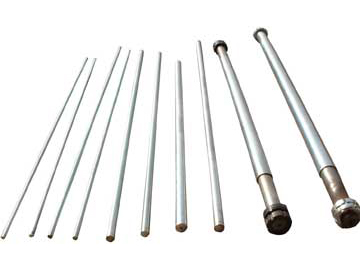Linear Shaft: Core Component For Precision Motion And Selection Guide
Release time:2025-12-15
Visits:0
In industrial fields such as automation equipment, precision machine tools, and medical instruments, linear shafts serve as core motion components, undertaking the critical task of achieving high-precision linear motion. Through their low-friction and high-strength characteristics, they ensure the long-term stable operation of mechanical systems. This article provides an in-depth analysis of the structural characteristics, application scenarios, and selection key points of linear shafts, offering practical references for industrial design and equipment maintenance.
1. High Hardness and Wear Resistance
Linear shafts are typically made of SUJ2 steel (equivalent to national standard GCr15), with a surface hardness of HRC60±2 and a hardened layer depth of 0.8-3mm, enabling them to withstand heavy loads and frequent motion while reducing wear during long-term use.
2. Precision Machining Technology
Through high-frequency heat treatment and precision grinding technology, the surface roughness of linear shafts is controlled within Ra0.10μm-0.35μm, and the straightness error is less than 70μm/1000mm, ensuring smooth motion without jitter, suitable for micron-level precision scenarios.
3. Diversified Surface Treatments
- Chromium-Plated Linear Shafts: Hard chromium plating on the surface of ordinary linear shafts improves rust resistance, suitable for harsh environments such as humidity and dust, commonly used in automated robotic arms and conveyor systems.
- Stainless Steel Linear Shafts: Made of stainless steel, they possess corrosion resistance and acid-alkali resistance properties, suitable for scenarios with strict hygiene requirements such as medical equipment and food processing.
4. Low-Friction Design
Optimized geometric structures and surface treatment technologies significantly reduce the friction coefficient, minimize energy consumption, and extend the service life of supporting bearings.
2. Main Application Fields of Linear Shafts
1. Industrial Automation: Used in positioning and transmission components of manipulators and automated production lines to improve production节拍 and repeat positioning accuracy.
2. Precision Machine Tools: As core components of CNC machine tool guide rails, they ensure cutting accuracy and processing efficiency.
3. Medical Equipment: Achieve precise displacement control in sterile environments in devices such as surgical robots and testing instruments.
4. Printing and Packaging Machinery: Ensure high-precision conveying and alignment of paper and materials, avoiding jamming or deviation.
5. Special Environment Equipment: In marine engineering and chemical equipment, stainless steel or chromium-plated linear shafts can resist corrosion from corrosive media.
3. Classification and Technical Selection of Linear Shafts
1. Ordinary Linear Shafts (SF Type)
Basic-type linear shafts suitable for scenarios with conventional load and precision requirements, such as conveyor belts and general machinery.
2. Chromium-Plated Linear Shafts (SFC Type)
Enhanced surface hardness and rust resistance through electroplating technology, suitable for dusty and high-humidity environments, commonly used in logistics sorting systems and outdoor equipment.
3. High-Precision Linear Shafts
With a straightness error of ≤50μm/300mm, they are used in ultra-precision fields such as semiconductor equipment and optical instruments.
4. Hollow Linear Shafts
Manufactured using warm forging technology, they balance lightweight and high strength, suitable for weight-sensitive aerospace equipment.
4. Key Selection Factors and Precautions
1. Load and Rigidity Matching
Select the linear shaft diameter and material based on the maximum load of the equipment. For example, heavy-load equipment requires high-strength linear shafts with a diameter of ≥30mm to avoid deformation.
2. Accuracy Grade Adaptation
Ordinary equipment can use standard linear shafts with radial runout of 0.01-0.03mm; precision instruments require high-end models with runout ≤0.005mm.
3. Environmental Adaptability
In humid, high-temperature, or chemically corrosive environments, prioritize chromium-plated or stainless steel linear shafts and regularly inspect the surface condition.
4. Installation and Maintenance Convenience
Some linear shafts are designed as open or gap-type, supporting quick adjustment and replacement, suitable for equipment requiring frequent maintenance.
Summary: As the "motion skeleton" of modern industry, the performance of linear shafts directly affects equipment efficiency and lifespan. Through reasonable selection, regular maintenance, and suitable surface treatment solutions, their technical advantages can be maximized, helping enterprises reduce costs and increase efficiency.
